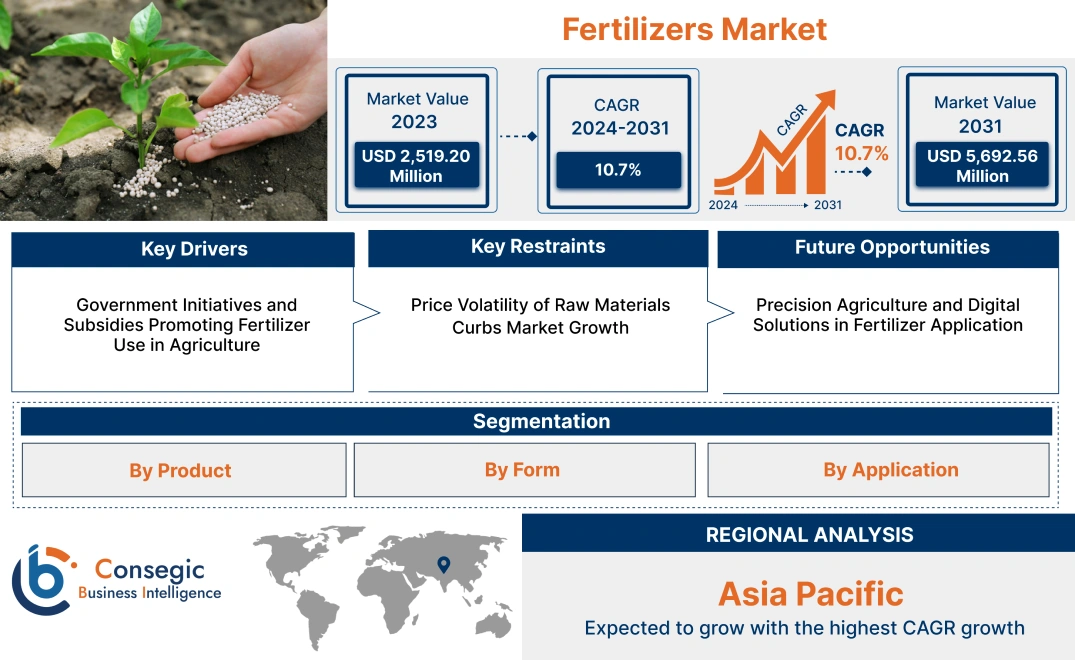- Summary
- Table Of Content
- Methodology
Fertilizers Market Size:
Fertilizers Market size is estimated to reach over USD 5,692.56 Million by 2031 from a value of USD 2,519.20 Million in 2023 and is projected to grow by USD 2,744.57 Million in 2024, growing at a CAGR of 10.7% from 2024 to 2031.
Fertilizers Market Scope & Overview:
The fertilizers are substances that enhance soil fertility and promote plant flourishing. It includes key nutrients like nitrogen, phosphorus, and potassium (NPK), which are essential for healthy crop development. They are categorized into synthetic, organic, and bio-fertilizers, each serving specific agricultural needs. The primary features of fertilizers are their ability to increase crop yields, improve soil nutrient content, and support sustainable agriculture practices. The benefits of using this include enhanced plant productivity, improved crop quality, and efficient nutrient management. Applications cover a wide range of crops including cereals, fruits, vegetables, and oilseeds, supporting end-users such as farmers, agricultural cooperatives, and commercial plantations. The market is driven by the growing opportunity for the global population, increased food demand, and the need for efficient agricultural practices to optimize land use.
Fertilizers Market Dynamics - (DRO) :
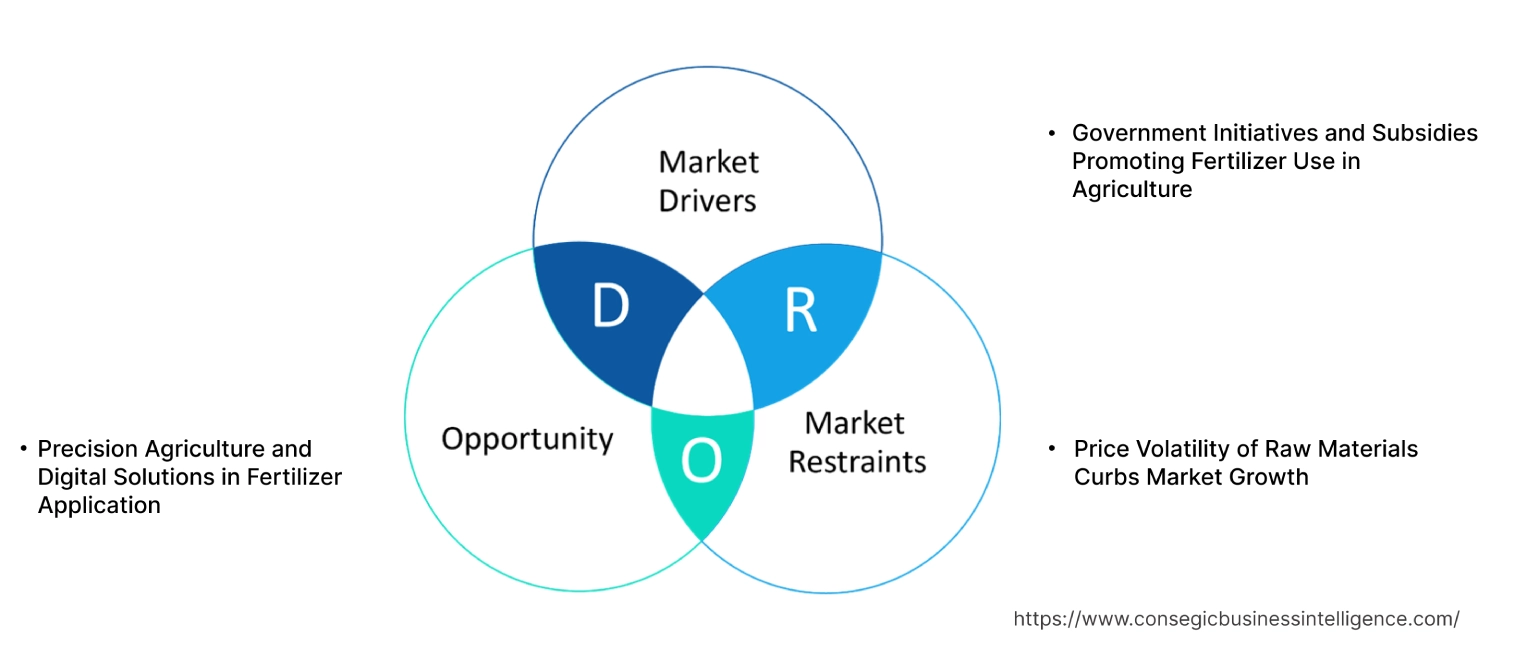
Key Drivers:
Government Initiatives and Subsidies Promoting Fertilizer Use in Agriculture
Government support through subsidies, incentives, and agriculture-focused policies is a significant factor propelling the market. Recognizing the importance of fertilizers in enhancing food security, many governments, especially in developing nations, provide fertilizer subsidies to make these essential inputs more affordable for farmers leading to further expansion. In India, for example, substantial government funding underpins the availability of compost at subsidized rates, encouraging farmers to adopt fertilization practices that enhance productivity and support rural economies. Furthermore, government programs and policies often target balanced nutrient use, aiming to correct issues such as nitrogen overuse by incentivizing a more balanced application of NPK and micronutrients. In several regions, governments are also fostering innovation in fertilizer technology, investing in research and development for bio-based, low-emission fertilizers. For instance, the adoption of precision agriculture and nutrient management strategies supported by public-private partnerships is increasing, which directly benefits the fertilizer industry by promoting sustainable, high-efficiency applications. These efforts not only bolster fertilizer market growth but also drive industry innovation toward environmentally friendly and economically viable fertilizer products.
Key Restraints :
Price Volatility of Raw Materials Curbs Market Growth
Another significant challenge in the market is the price volatility of raw materials required for fertilizer production, particularly nitrogen, phosphate, and potash. These raw materials are often closely linked to global oil and natural gas prices, as energy-intensive processes are required to produce them, especially nitrogen-based products. Geopolitical tensions, trade restrictions, and supply chain disruptions frequently lead to price fluctuations, affecting the cost structure for its manufacturers. For instance, natural gas price spikes directly impact ammonia production costs, which is a primary input for nitrogen fertilizers. Additionally, dependency on imported raw materials, especially phosphate and potash, exposes producers to international market fluctuations and trade policies. Such volatility makes it challenging for the manufacturers to maintain stable pricing, affecting their profitability and, in turn, impacting farmers who may reduce their usage when prices are high. This price unpredictability hampers long-term planning and investments, particularly in regions heavily dependent on imports for inputs.
Future Opportunities :
Precision Agriculture and Digital Solutions in Fertilizer Application
The integration of precision agriculture and digital technologies in this application offers a promising expansion in fertilizers market opportunity. Precision agriculture technologies, such as soil mapping, drone surveillance, and sensor-based nutrient management, enable farmers to apply compost in precise amounts, tailored to the specific needs of different crop areas. This minimizes waste, improves nutrient use efficiency, and reduces the environmental impact associated with over-fertilization. Moreover, digital platforms and mobile applications are now being used to provide real-time data on soil health, crop needs, and optimal application schedules. This data-driven approach empowers farmers to make more informed decisions, increasing crop yields while reducing input costs. Companies that invest in providing digital solutions, such as sensor-embedded equipment and software platforms, are likely to see increased demand, especially among commercial-scale farms in developed regions. As awareness and accessibility of precision agriculture increase, particularly in emerging markets, the adoption of technology-driven solutions is expected to expand, opening up new revenue streams for the fertilizer industry.
Fertilizers Market Segmental Analysis :
By Product:
Based on product type, the market is segmented into organic and inorganic.
The inorganic segment accounted for the largest revenue fertilizers market share in 2023.
- Inorganic fertilizers, composed of synthetic chemicals and minerals, are widely used in large-scale agriculture due to their high nutrient content and immediate availability to plants.
- These, including nitrogen, phosphate, and potash-based products, are preferred for their efficiency in boosting crop yields and meeting the nutritional requirements of different soil types.
- The analysis shows increasing demand for high-yield crop production, driven by growing global food needs and shrinking arable land, has solidified the dominance of inorganic compost substances.
- Additionally, advancements in formulation, such as controlled-release and water-soluble, have enhanced the effectiveness of inorganic fertilizers, further supporting market expansion.
- Hence, inorganic fertilizers dominate the market, driven by their high nutrient content, immediate efficacy, and advancements in formulation that improve crop yield and nutrient efficiency.
The organic fertilizers segment is anticipated to register the fastest CAGR during the forecast period.
- Organic fertilizers, derived from natural sources like plant residues, animal manure, and compost, are gaining popularity due to their environmental benefits and sustainable farming practices.
- The rising consumer preference for organic food products and the increasing adoption of sustainable agricultural methods are major drivers of this segment.
- Organic fertilizers enhance soil health, improve microbial activity, and provide a balanced nutrient supply, making them ideal for long-term soil fertility.
- The growing focus on reducing chemical inputs and promoting eco-friendly farming solutions is expected to propel the rapid development of organic compost.
- Therefore, according to the analysis, organic fertilizers are expected to grow rapidly, supported by increasing application for sustainable agricultural practices and the rising consumer preference for organic food products.
By Form:
Based on form, the market is segmented into dry and liquid.
The dry fertilizers segment accounted for the largest revenue share in 2023.
- Dry fertilizers are widely used in agriculture due to their ease of application, longer shelf life, and high nutrient concentration.
- Granular and powder formulations offer flexibility in usage, allowing farmers to apply them through broadcasting or blending with soil amendments.
- Dry fertilizers are particularly effective for base and pre-plant applications, providing sustained nutrient release over time.
- The strong trends for dry fertilizers in large-scale farming operations, combined with advancements in formulation that improve nutrient efficiency, support their leading position in the market.
- Therefore, dry fertilizers lead the fertilizer market trends, driven by their high nutrient concentration, ease of application, and effectiveness in large-scale agricultural practices.
The liquid fertilizers segment is anticipated to register the fastest CAGR during the forecast period.
- Liquid fertilizers are gaining traction due to their rapid absorption, uniform distribution, and suitability for precision farming techniques.
- These can be applied directly to the soil or through foliar feeding, providing immediate nutrient availability to plants.
- The growing adoption of drip irrigation and fertigation systems, particularly in high-value crops, is driving the trends for liquid fertilizers.
- Additionally, advancements in formulation, such as chelated nutrients and micronutrient blends, have enhanced the efficacy of liquid fertilizers, making them a preferred choice for modern farming practices.
- Liquid fertilizers are expected to grow rapidly, driven by their suitability for precision farming and increasing adoption in high-value crop production, supported by advancements in nutrient formulations.
By Application:
Based on application, the market is segmented into agriculture, horticulture, gardening, and turf & landscaping.
The agriculture segment accounted for the largest revenue share of 58.77% in 2023.
- Agriculture is the primary consumer of fertilizers, driven by the need to enhance crop yields and ensure food security.
- The use of both organic and inorganic fertilizers in large-scale farming operations is essential for meeting the nutritional needs of a wide variety of crops, including cereals, oilseeds, and pulses.
- The rising fertilizers market demand for staple foods, combined with the need to improve soil fertility and manage nutrient deficiencies, is driving the adoption in agriculture.
- The segment's growth is further supported by government initiatives and subsidies aimed at promoting the usage of fertilizers to boost agricultural productivity.
- Thus, the agriculture segment leads the market trends due to its high usage to enhance crop yields and meet global food production needs, supported by government initiatives for sustainable agriculture.
The horticulture segment is anticipated to register the fastest CAGR during the forecast period.
- Horticulture, which includes the cultivation of fruits, vegetables, and ornamental plants, requires specialized compost to support high-value crops with specific nutrient requirements.
- The growing consumer application for fresh produce, coupled with the increasing adoption of greenhouse and hydroponic farming methods, is driving the trend for tailored compost in horticulture.
- Organic and specialty fertilizers are particularly favored in this segment due to their benefits in improving crop quality and soil health.
- As the focus on high-value crop production and sustainable practices intensifies, the horticulture segment is expected to experience significant growth.
- The horticulture segment is expected to grow rapidly, driven by the fertilizers market demand for high-value crops and the increasing adoption of advanced farming methods, including greenhouse and hydroponic systems.
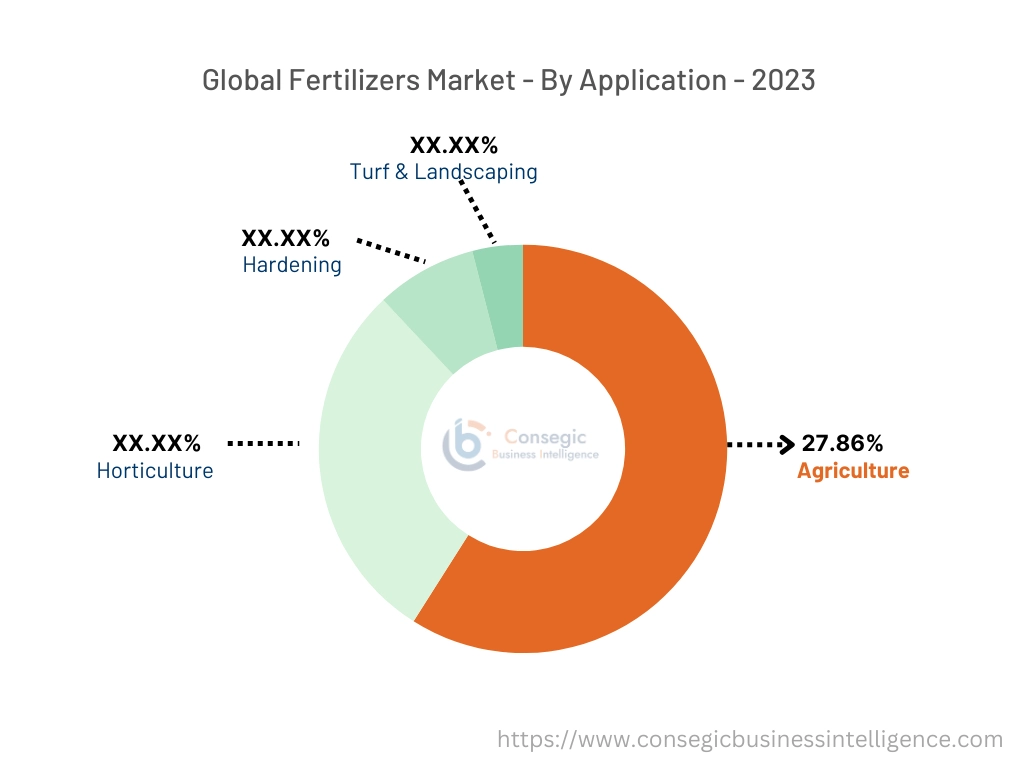
Regional Analysis:
The regions covered are North America, Europe, Asia Pacific, the Middle East and Africa, and Latin America.
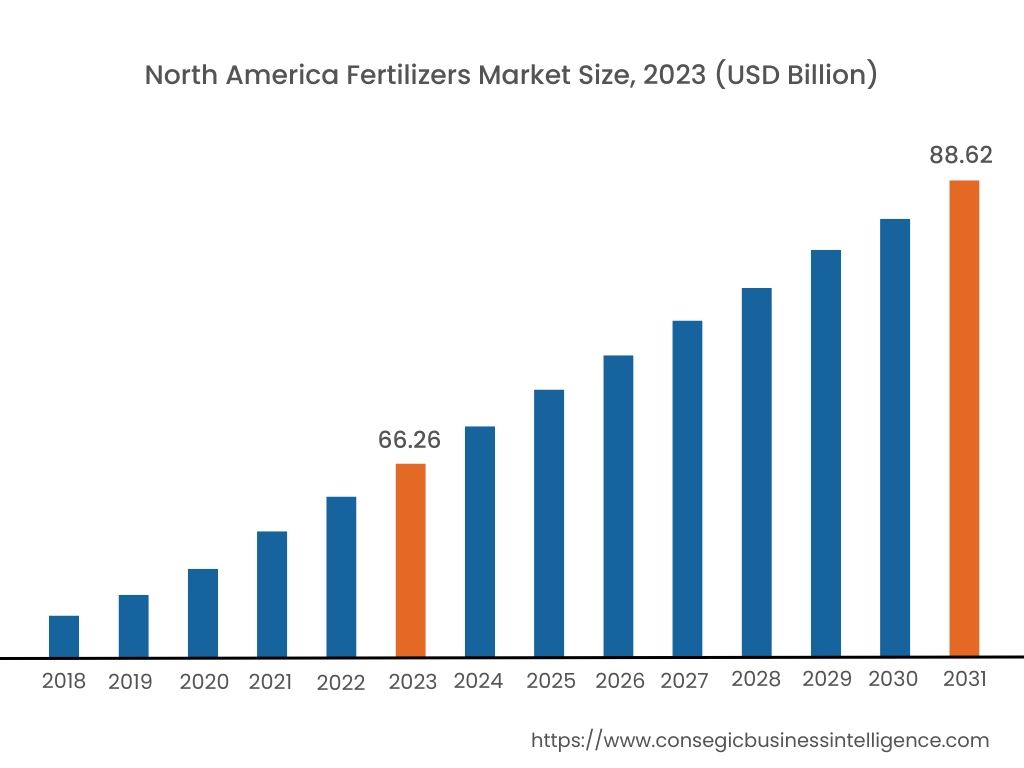
In 2023, North America accounted for the highest market share at 34.10% and was valued at USD 66.26 Billion and is expected to reach USD 88.62 Billion in 2031. In North America, the U.S. accounted for the highest share of 68.20% during the base year of 2023. North America holds a prominent share depicted in the fertilizers market analysis, driven by the region's extensive agricultural activities, especially in the United States and Canada. The strong adoption of modern farming techniques and high usage of inorganic are supporting fertilizers market growth. The demand for specialty fertilizers is also increasing due to rising concerns over soil health and sustainability. The government's support for sustainable farming practices and the adoption of precision agriculture further contribute to the regional fertilizers market expansion.
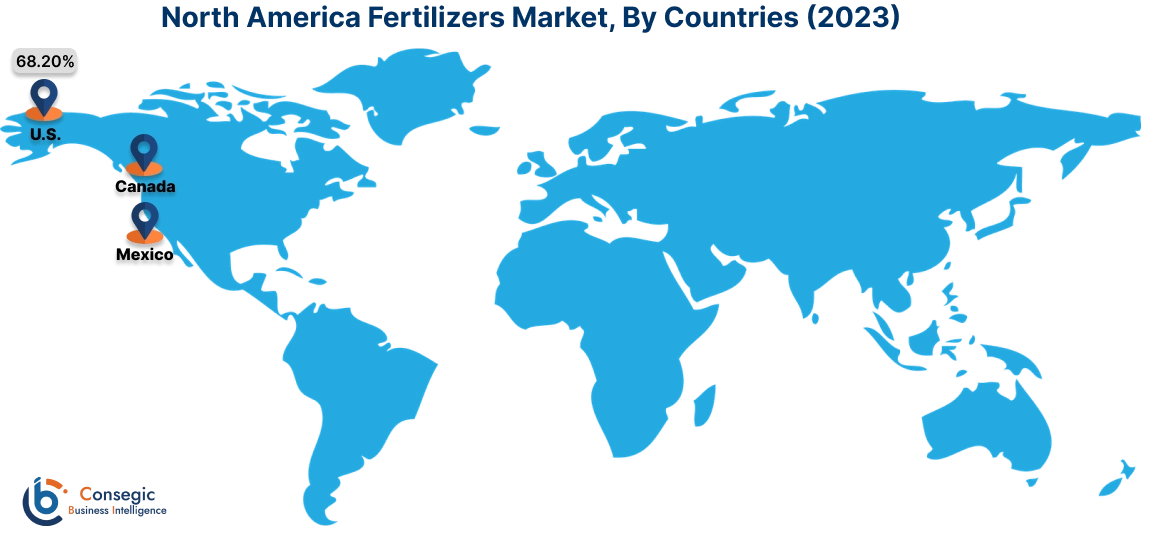
In Asia Pacific, the market is experiencing the fastest growth with a CAGR of 4.2% over the forecast period. Asia-Pacific is the largest and fastest-growing region in the market, attributed to the high agricultural output in countries like China, India, and Indonesia. The rising population, increasing food consumption, and need for higher crop yields are key factors propelling the market. Governments in the region are offering subsidies and incentives for the usage to enhance agricultural productivity. The growing adoption of both organic and inorganic fertilizers, along with advancements in farming technologies, is expected to sustain the market's growth.
The European market is influenced by the region's focus on sustainable and organic farming practices. Countries like Germany, France, and Spain are leading in the production and consumption. The stringent regulations on chemical fertilizers and the promotion of organic alternatives are shaping the market dynamics. The increasing awareness of environmental impacts and the shift toward organic are expected to drive significant growth, especially in the horticulture and gardening sectors.
In Latin America, the fertilizers market trends are driven by the expanding agricultural sector in Brazil and Argentina. The region's favorable climate and large arable land area support high consumption. The analysis shows the, shift towards more efficient nutrient management practices and the growing use of biofertilizers in sustainable farming are notable trends. Additionally, the demand is bolstered by the increased cultivation of cash crops like soybeans and corn, which require substantial nutrient inputs.
The fertilizers market analysis in the Middle East & Africa is experiencing steady growth due to increasing agricultural activities and government initiatives to achieve food security. The arid climate and poor soil quality in the region necessitate the usage to enhance crop yields. Countries like Saudi Arabia, Egypt, and South Africa are investing heavily in modernizing agricultural practices. The rising adoption of liquid fertilizers and the growing focus on sustainable farming practices are expected to further drive fertilizers market growth in the region.
Top Key Players & Market Share Insights:
The fertilizers market is highly competitive with major players providing products and services to the national and international markets. Key players are adopting several strategies in research and development (R&D), product innovation, and end-user launches to hold a strong position in the global fertilizer market. Key players in the fertilizers industry include -
- Bayer AG (Germany)
- K+S AG (Germany)
- Koch Industries, Inc. (United States)
- OCI N.V. (Netherlands)
- Sinofert Holdings Limited (China)
- Nutrien Ltd. (Canada)
- Yara International ASA (Norway)
- The Mosaic Company (United States)
- CF Industries Holdings, Inc. (United States)
- ICL Group Ltd. (Israel)
Recent Industry Developments :
Partnerships and Collaborations:
- In September 2023, SABIC Agri-Nutrients partnered with BiOWiSH Technologies and ADM to promote sustainable farming. Their biologically-enhanced urea fertilizer reduces greenhouse gas emissions and enhances soil carbon sequestration, aiding efficient, eco-friendly agriculture.
- In May 2023, Bunge Limited and Nutrien Ag Solutions formed a strategic alliance to support U.S. farmers in adopting sustainable practices and producing lower-carbon products.
Fertilizers Market Report Insights :
| Report Attributes | Report Details |
| Study Timeline | 2018-2031 |
| Market Size in 2031 | USD 257.76 Billion |
| CAGR (2024-2031) | 3.7% |
| By Product |
|
| By Form |
|
| By Application |
|
| By Region |
|
| Key Players |
|
| North America | U.S. Canada Mexico |
| Europe | U.K. Germany France Spain Italy Russia Benelux Rest of Europe |
| APAC | China South Korea Japan India Australia ASEAN Rest of Asia-Pacific |
| Middle East and Africa | GCC Turkey South Africa Rest of MEA |
| LATAM | Brazil Argentina Chile Rest of LATAM |
| Report Coverage |
|
Key Questions Answered in the Report
What is the current size of the Fertilizers Market? +
The global fertilizers market size is valued at USD 194.30 Billion in 2023.
What are the key drivers of the Fertilizers Market? +
Rising demand for high agricultural yield, increasing population, and shrinking arable land are the primary drivers of the market.
Which type of fertilizer dominates the market? +
Inorganic fertilizers hold the largest share due to their effectiveness in boosting crop yields and their widespread availability.
What is the fastest-growing segment in the Fertilizers Market? +
Organic fertilizers are witnessing the fastest growth, driven by increasing consumer preference for sustainable and eco-friendly agricultural practices.
Which region is leading in the Fertilizers Market? +
Asia-Pacific is the leading region due to the high agricultural activity and large population, especially in countries like India and China.
